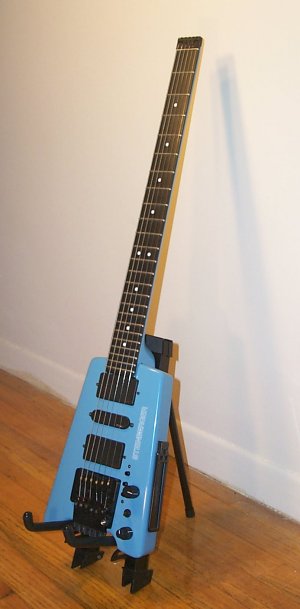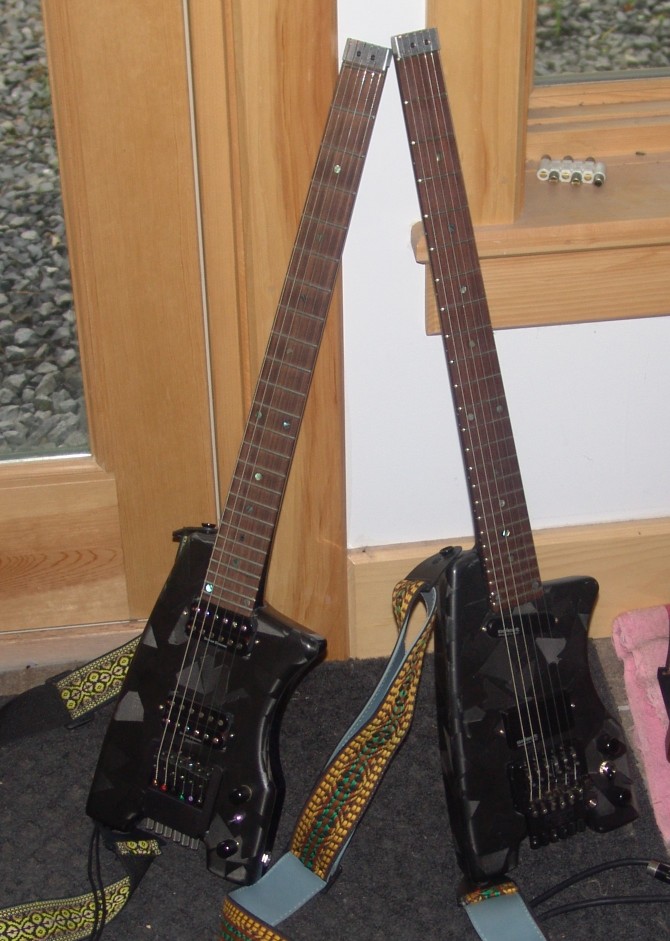LBG Carbon Graphite Composite Guitars
(See an article about these guitars on the Gibson web site)
(See more information about my graphite guitars on my MySpace page)
History
The original design of headless guitars and basses goes back to an electric guitar icon, Les Paul. Further developments were achieved by Dave Bunker.
Back in the 1980's, Ned Steinberger popularized the headless bass, and then the headless guitar. Initially, the instruments that he produced were made of graphite fiber composite. In this aspect, as in many others, he was way ahead of his time.
The flagship Steinberger guitar was the GL series, an example of which is shown below. Made of one solid slab of carbon graphite, with a separate bolt-on face plate, it was both striking and amazing. The lack of wood made the instrument stable over wide ranges of temperature and humidity, and use of double-ball strings made the tuning even more stable. And the look was unmistakable, unusual. The finger board was made of phenolic resin.

(Note that the bottom side of the guitar is straight and angled, which means that the guitar will slide off of your thigh unless the leg-rest is extended.)
The GL was very popular with a small group of afficianados, but the number of instruments produced was limited, and production ended in 1998. A total of about 8,000 graphite instruments (both guitars and basses) were produced. Today, the GLs are vintage instruments that are expensive, if you can find one at all. The most rare specimens now sell for over $6,000. A complete history of the Steinberger guitar line can be found at
www.steinbergerworld.com.
For years, those of us who admire the minimalist headless guitar design were left to either pony up larger and larger amounts of money for an original GL, or to make do with the likes of the Spirit GT Pro or the Steinberger P series.
A few years ago, luthier Phil Langley decided to try to create a new graphite headless guitar with a minimal body profile. He started with the general GL shape, added an ergonomic curve so that the guitar plays well when rested on the thigh, and came up with a design that is much lighter than the original GL. Manufactured out of one large slab of carbon graphite composite, the finger boards are rosewood. The result is the guitar shown below.

Two guitars of the original pre-production guitars. The "silver" colored headpieces are now black.

Close-up of one of the bodies, showing the triangular graphite patterns, along with the ergonomic thigh rest. Different triangles appear and disappear as the guitar moves, producing a "sparkling" effect.

Demonstration of the effectiveness of the thigh rest.
The original GL guitars weighed about 7.25 pounds, with a Trans Trem. The new LBG graphite guitars weigh 4.5 pounds, with one of my fixed bridges, almost half of the weight. The difference is more dramatic than these numbers might sound. It feels so light that one imagines it is a toy, and yet it is one of the strongest and high-tech bodies made today. And it makes playing long gigs much less of a strain on your back and neck!
Phil sold his business to me in 2008, and I am now offering these guitars for sale.
The Guitars
Luthier
Rick Canton has played these guitars, and said the following about them:
The LBG guitar has a clear and
airy resonance that is even on all notes across the fretboard.
The sound of the GL is very "accurate"
and "defined", with lots of control over the vowel effect after the note is picked; the LBG guitar is more
resonant, and
sounds less "dense". When holding chords, the notes seem to bloom over time.
Put another way,
if you blend a GL with a Parker, you will get an LBG, with the Parker adding the "ariness" to the GL sound.
The neck profile is like a Moses but a tad wider, not like a Newburgh GL/GM.
This is the lightest electric guitar I have ever played. The guitar has an ergonomic knee
contour that helps angle the neck to a
comfortable playing position when sitting. When standing, there is no neck hang:
the guitar is very evenly balanced. It has similar edge contours as
the GL so you don`t end up with any uncomfortable feeling with your right
arm/hand.
Musician
Dave Rowe had this to say about them:
When Jon first pulled out the guitars at my studio, I was immediately taken by the resemblance to the GL, but with the modified bottom bout--hey look mom, no leg rest! I'll never forget the first time I picked up an L series Steinberger and was astonished by the heft of the instrument relative to its diminutive size. This experience was exactly the opposite of that! When Jon first handed the guitar to me, I believe the words out of my mouth were, "Holy-sh*t, what's this thing made of?" The guitar is incredibly light, at 4.5 lbs. it really doesn't seem like it could possibly be taken seriously...until you plug it in. From lightweight guitar to heavyweight tone. It can sparkle and growl. With a list of possible pickup configurations longer than my arm, Jon's guitars will surely be a prized part of any guitar arsenal.
One of the buyers had this to say about the guitar:
Tonal quality of the
guitar is excellent. I'm a mid and high person so the lighter low end of
this guitar, even with a powerful JB, fits my taste.
I once put a P-rail on my wooden-bodied
headless but gave up after 30 minutes as it sounded unclear. The
graphite body make this pickup sound surprisingly airy with clear contour even
in the front. In fact P-90 setting of P-rail sounds so sweet on this
guitar!
You can see some pictures of the internals of the guitars by clicking here. You can view a small (5 MB) movie showing the trangle "sparkles" by clicking here.
Current Inventory
The initial run of six pre-production guitars are now available at a discounted price. They have fixed pickup configurations, and all are finished with a clear coat, which allows the underlying graphite pattern to be seen. The graphite triangles "twinkle" as the instrument moves.
All guitars come with a Ritter gig bag, and all have stainless steel frets.
The neck has a truss rod, that can be adjusted at the body end of the neck.
The neck width at the zero fret is 1.67"; the neck thickness there is 0.88" (including the fret and the strings [the guitar was strung when I took the measurement]).
The neck width at the 12th fret is 1.99"; the neck thickness at the 12th fret is 0.90" (including the fret, but not the strings).
Neck scale is 25.5". Neck radius is 12".
The following six guitars are available for immediate delivery, at prices $500 below the cost of production guitars:
-
1) Dual humbucker configuration, with slight blue tint to the clear coat.
Routed for a Trans Trem, S-Trem, or Bondy fixed bridge.
As shown, with Bondy fixed bridge, $2,000.
Click here for pictures.
This Instrument has been sold!
-
2) Humbucker at the bridge, single coil at the neck, clear coat.
Routed for a Trans Trem, S-Trem, or Bondy fixed bridge.
As shown, with Bondy fixed bridge, $2,000.
Click here for pictures.
This Instrument has been sold!
-
3) Dual humbucker configuration. Routed for a Trans Trem, S-Trem, or Bondy fixed bridge.
As shown, with Bondy fixed bridge, $2,000.
Click here for pictures.
This Instrument has been sold!
-
4) Humbucker at the bridge and two additional single coils, with 5-way switch.
Routed for a Bondy fixed bridge, but can be modified to accept Trans-Trem,
S-Trem, or XS-Trem by routing out the pocket for the return spring.
As shown, with Bondy fixed bridge, $2,000.
Click here for pictures.
This Instrument has been sold!
-
5) Wooden faceplate with piezo pickups in the saddles and no magnetic pickups. Can be configured for 1/4" monophonic output or hexaphonic output or both. Routed for a Trans Trem, S-Trem, or Bondy fixed bridge. Price will depend on which GraphTech electronics boards you wish to have installed. Click here for pictures.
-
6) Wooden faceplate with piezo pickups in the saddles and no magnetic pickups. Can be configured for 1/4" monophonic output or hexaphonic output or both. Routed for an R-Trem, or Bondy fixed bridge. Price will depend on which GraphTech electronics boards you wish to have installed. Click here for pictures.

Pre-production instrument number 4
Once these six guitars are spoken for, additional instruments will be available as custom builds. You can specify the pickup make and model, the pickup locations, the bridge type (fixed or trem), and the finish. GraphTech Ghost piezo systems (both monophonic and hexaphonic) are also available.
These instruments will start at $2,500 for a fixed bridge and inexpensive pickups. Instruments with trems and more expensive pickup systems will cost more.
Please contact me at jon@jonbondy.com if you are interested in purchasing one of these instruments.
